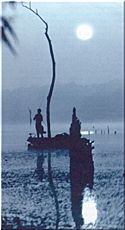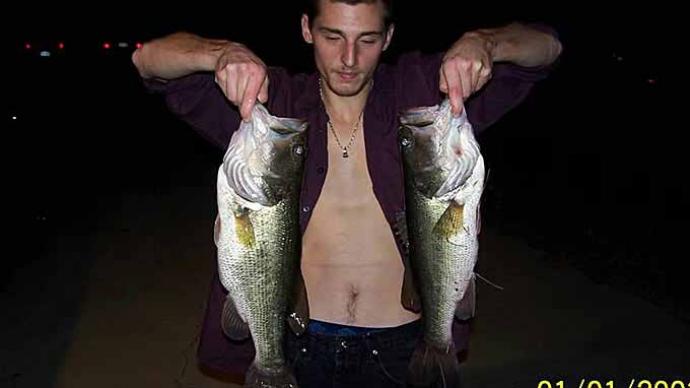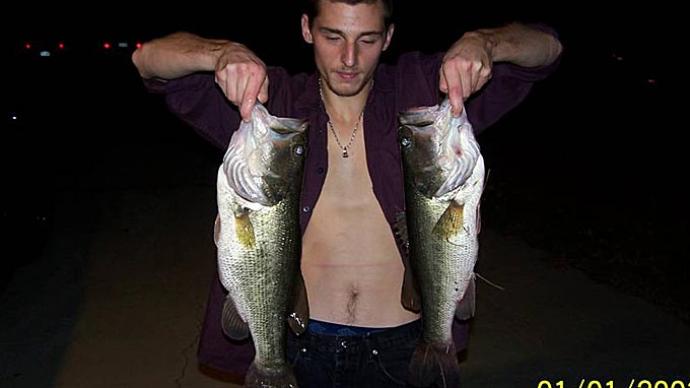
If you are the squeamish type afraid of things that go bump in the night, you're missing out on one of the most exciting ways to catch bass, especially right now.
Bass fishing at night is nothing new. It dates back to the early days of artificial lures, although it wasn't prevalent then, and it gained in popularity in the 1960s with the advent of the bass boat.
Today's night bassers use mainly worms or lizards and spinnerbaits, but old-timers will tell you that if you want the ultimate experience in nighttime bass fishing, you must try topwater fishing.
Having a bass blow up on your topwater lure is a thrilling experience at any time, but it is especially spine-tingling when it happens at night when you can hear your lure working and hear the explosion of the strike but can't see a thing.
Modern-day anglers have set some standards for night fishing, so much so that many of them have become too set in their ways to try anything different. The arsenal you use for bass fishing at night is no different than what you use during the day. That's because bass prowl the same waters day or night, and the so-called best lure to use depends upon the type of water you are fishing.
At Lake Bryson (Texas) recently, I used an old hat trick to catch six bass within about an hour and a half - a black Jitterbug. Although Arbogast still manufactures the lure, newer lures have grabbed the attention of many of today's anglers who keep wobbling-type artificial lures like the Jitterbug isolated from much of the action. If you question that, just look at five of your buddies' tackle boxes and count the number of Jitterbugs you see.
Lake Bryson, for those of you who have never heard of it, is a small lake of about 700 acres located between Jacksboro and Graham near the small town of Bryson. It is a rocky-lined, clear lake full of coontail moss and timber. There is only one small ramp on the lake. It's virtually a small piece of concrete behind a heavily rutted, steep-sloped bank that makes launching a modern bass boat difficult unless you have a four-wheeled drive vehicle. Nevertheless, the lake has a good bass population, and because of its extremely clear waters, I think the best time to fish is at night.
The Jitterbug is one of my favorites for night bass fishing because it causes such a commotion and can be stopped periodically beside a stump or over submerged bass. This action often draws a response from even the most timid largemouth.
The first bass to hit the Jitterbug that night was a three-pounder that clobbered the lure in a small pocket no more than 20 yards from the ramp. It came on my third cast and helped set the stage for the action I would have on a time-limited fishing trip. The other bass I caught that night were mostly two- to three-pounders, with a five-pounder the largest. Those are what many call nice-sized fish, but they don't compare to the big fish Bryson has produced over the past few years by the handful of anglers who venture there regularly.
There are many lakes in Texas where night fishing has become even more popular, most of which are much larger than Bryson. Lake Fork, for example, produces many big fish annually for night anglers. Toledo Bend, Sam Rayburn, Amistad, and O.H. Ivie are others noted for their dark-of-the-night action.
At Fork, where Joe Axton of Axton's Bass City holds several night bass tournaments each summer and enjoys night fishing himself, plastic worms rigged Carolina-style and spinnerbaits appear to be the most often-used lures. Still, at Amistad, topwaters play a key role in many catches. Toledo Bend and Rayburn produce many bass at night on both Texas- and Carolina-rigged worms, lizards, and spinnerbaits. Still, they can provide some thrilling experiences on topwaters, too, especially in the backs of the creeks and coves.
Summertime is by far the most popular time for bass fishing at night. And there are several reasons why. For one, bass can be caught relatively regularly in deep and shallow water during hot weather. Secondly, the temperatures are much cooler at night than during the day, and thirdly, it provides a great escape from the daytime crowds. A full moon isn't a must for night fishing, but it helps. For one thing, bass feed more during a bright moon than when there is no or little moon. Also, any moonlight at all will help you make out timber, boat docks, and other objects when you are making a cast.
If you have never tried fishing for bass at night but plan to do so soon, there are several precautions you should take before setting out.
First, if you are used to not getting onto the water until after daybreak, you must ensure your running lights are working correctly. They are required by law, of course, but little-used running lights tend to suddenly not work for one reason or another - a blown fuse, a broken bulb, or corrosion build-up on the terminals, for example.
Make a checklist of things you will need. Take two flashlights (yes, two, because if one doesn't work, you will have a backup). You'll need a pair of needle-nose pliers (you won't be able to watch your line, and there always is a chance of letting a bass have the worm too long and hooking it deep) and plenty of insect repellant (fishing shallows near flooded weeds can attract mosquitoes to you).
The choice of lures should depend upon the type of water you expect to fish. Clear-water lakes can produce fantastic topwater action, whereas a plastic worm or spinnerbait may be best for a murky lake.
Lakes with lighted docks are good bets on any type of lake, and you might even be able to catch some fish on a suspended crankbait fished around them. The color you choose for your lure is a personal choice, the same as it often is during the daytime, but most experienced night fishermen will tell you to go with something dark like black or blue, for instance. That's because they figure that a dark-colored lure can be more easily sky-lighted, making it easier for the bass to see the lure rather than just feel its vibrations through its lateral lines.
Jim Brown of Mansfield believes in dark-colored lures so much that he began painting the blades of his black-skirted spinnerbaits black years ago.
Many lakes and even stock tanks can provide great night action. My preference for bass fishing at night is clear water with aquatic vegetation such as coontail moss, hydrilla, etc., in relatively shallow water, such as a creek or cove.
I've caught my share of deep-water bass on plastic worms. But I have found that unless you are fishing a new lake where the bass are so heavily populated that they often hold in schools around structure, there is better success in searching for bass actively hunting for food in the shallows.
Another reason I like shallow-water fishing is because I got spoiled by the thrills that come from topwater fishing when you can barely see your lure on the surface or can't see it at all. And, besides, if you favor fishing a plastic worm, you might be surprised how many bass you can catch on it in the dark shallows.
Using rattles is also a plus for night fishing. Just as the vibrations of a spinnerbait will attract bass, a rattle inside a plastic worm or on a spinnerbait or crankbait could be just the ticket to drawing a strike.
If you decide to give it a try, remember to observe all safe-boating rules. Ask a partner to go along with you. Make sure someone at home knows where you will be fishing and when to expect your return, and ensure your running lights are working. If you use a spotlight to see your way to and from your fishing areas, remember that there may be other anglers on the lake, too, and avoid shining your spotlight on them and on shorelines that campers are using. Launch your boat as close as possible to the area you plan to fish so you won't have a long boat run, and always check the weather before heading out into the darkness.




